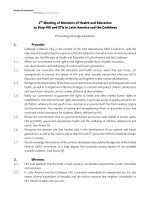the mit press poverty inequality and policy in latin america feb 2009
Bạn đang xem bản rút gọn của tài liệu. Xem và tải ngay bản đầy đủ của tài liệu tại đây (3.7 MB, 333 trang )
Po v e r t y, I n e q u a l i t y, a n d
Policy in Latin America
edited by Stephan Klasen and
Felicitas Nowak-Lehmann
Seminar Series
Poverty, Inequality, and Policy in Latin America
CESifo Seminar Series
edited by Hans-Werner Sinn
Structural Unemployment in Western Europe: Reasons and Remedies
Martin Werding, editor
Institutions, Development, and Economic Growth
Theo S. Eicher and Cecilia Garcı
´
a-Pen
˜
alosa, editors
Competitive Failures in Insurance Markets: Theory and Policy Implications
Pierre-Andre
´
Chiappori and Christian Gollier, editors
Japan’s Great Stagnation: Financial and Monetary Policy Lessons for Ad-
vanced Economies
Michael M. Hutchison and Frank Westermann, editors
Tax Policy and Labor Market Performance
Jonas Agell and Peter Birch Sørensen, editors
Privatization Experiences in the European Union
Marko Ko
¨
thenbu
¨
rger, Hans-Werner Sinn, and John Whalley, editors
Recent Developments in Antitrust: Theory and Evidence
Jay Pil Choi, editor
Schools and the Equal Opportunity Problem
Ludger Woessmann and Paul E. Peterson, editors
Economics and Psychology: A Promising New Field
Bruno S. Frey and Alois Stutzer, editors
Institutions and Norms in Economic Development
Mark Gradstein and Kai A. Konrad, editors
Pension Strategies in Europe and the United States
Robert Fenge, Georges de Me
´
nil, and Pierre Pestieau, editors
Foreign Direct Investment and the Multinational Enterprise
Steven Brakman and Harry Garretsen, editors
Sustainability of Public Debt
Reinhard Neck and Jan-Egbert Sturm, editors
The Design of Climate Policy
Roger Guesnerie and Henry Tulkens, editors
Poverty, Inequality, and Policy in Latin America
Stephan Klasen and Felicitas Nowak-Lehmann, editors
See for a complete list of titles in this series.
Poverty, Inequality, and Policy in Latin America
edited by Stephan Klasen and Felicitas Nowak-Lehmann
The MIT Press
Cambridge, Massachusetts
London, England
( 2009 Massachusetts Institute of Technology
All rights reserved. No part of this book may be reproduced in any form by any elec
tronic or mechanical means (including photocopying, recording, or information storage
and retrieval) without permission in writing from the publisher.
For information about special quantity discounts, please e mail special sales@mitpress
.mit.edu
This book was set in Palatino on 3B2 by Asco Typesetters, Hong Kong.
Printed and bound in the United States of America.
Library of Congress Cataloging in Publication Data
Poverty, inequality, and policy in Latin America / edited by Stephan Klasen and Felicitas
Nowak Lehmann.
p. cm. (CESifo seminar series)
Includes bibliographical references and index.
Papers from a conference held at the Ibero America Institute for Economic Research in
Go
¨
ttingen, Germany, in July 2005 and cosponsored by the CESifo research network.
ISBN 978 0 262 11324 3 (hardcover : alk. paper)
1. Poverty Latin America Congresses. 2. Equality Latin America Congresses.
3. Latin America Economic policy Congresses. 4. Latin America Social
conditions Congresses. I. Klasen, Stephan. II. Nowak Lehmann D., Felicitas.
III. Universita
¨
tGo
¨
ttingen. Ibero Amerika Institut fu
¨
r Wirtschaftsforschung. IV. CESifo.
HC130.P6P715 2009
339.4
0
6098 dc22 2008029405
10987654321
Contents
Series Foreword vii
Introduction 1
Stephan Klasen and Felicitas Nowak-Lehmann
I The Transmission of Poverty and Inequality in Latin
America 17
1 The Colonial Origins of Inequality: Exploring the Causes and
Consequences of Land Distribution 19
Ewout Frankema
2 Earnings Inequality and Educational Mobility in Brazil over
Two Decades 47
Denis Cogneau and Je
´
re
´
mie Gignoux
3 Race Discrimination or Inequality of Opportunities: The
Brazilian Case 85
Phillippe G. Leite
II Spatial Dimensions of Poverty and Inequality in Latin
America 127
4 Consumption Growth and Spatial Poverty Traps: An Analysis
of the Effect of Social Services and Community Infrastructures
on Living Standards in Rural Peru 129
Philippe De Vreyer, Javier Herrera, and Sandrine Mesple
´
-Somps
5 Spatial Externalities between Brazilian Municipios and Their
Neighbors 157
Philippe De Vreyer and Gilles Spielvogel
III Economic Policy, Poverty, and Inequality in Latin
America 189
6 Macroeconomic and Distributional Effects of Devaluation in a
Dollarized Economy: A CGE Analysis for Bolivia 191
Rainer Schweickert, Rainer Thiele, and Manfred Wiebelt
7 Medium-Term Impacts of the Oportunidades Conditional
Cash-Transfer Program on Rural Youth in Mexico 219
Jere R. Behrman, Susan W. Parker, and Petra E. Todd
8 The Impact of Brazil’s Tax-Benefit System on Inequality and
Poverty 271
Herwig Immervoll, Horacio Levy, Jose
´
Ricardo Nogueira,
Cathal O’Donoghue and Rozane Bezerra de Siqueira
Appendix 303
Contributors List 315
Index 317
vi Contents
Series Foreword
This book is part of the CESifo Seminar Series. The series aims to
cover topical policy issues in economics from a largely European
perspective. The books in this series are the products of the papers and
intensive debates that took place during the seminars hosted by
CESifo, an international research network of renowned economists
organized jointly by the Center for Economic Studies at Ludwig-
Maximilians-Universita
¨
t, Munich, and the Ifo Institute for Economic
Research. All publications in this series have been carefully selected
and refereed by members of the CESifo research network.
Poverty, Inequality, and Policy in Latin America:
An Introduction
Stephan Klasen and Felicitas Nowak-Lehmann
The causes and consequences of high inequality in incomes, assets, and
many aspects of well-being in Latin America have recently re-emerged
as a central research and policy issue. While in previ ous decades, con-
cern about high inequality in Latin America was, following Kuznets’
seminal work in the 1950s, largely focused on the impact of the devel-
opment process on inequality, the new emerging literature is consid-
ering the reverse causality—that is, the impact of inequality on the
development process. Prominent examples of this renewed emphasis
include a number of reports produced recently by the World Bank,
such as the recent World Development Reports on Poverty (World
Bank 2000) and Equity (World Bank 2005), as well as reports focusing
on Latin America, including the 2004 report Inequality in Latin America:
Breaking with History (World Bank 2003) and the 2006 report Poverty
Reduction and Growth: Virtuous and Vicious Circles (World Bank 2006).
Similarly, academic research has taken on this issue with renewed vig-
or, as shown by works of Eicher and Turnovsky (2003), Deininger and
Squire (1998), and Forbes (2000), among many others.
There are a number of reasons leading to this re-emergence of in-
equality as a central research and policy issue in Latin America, as
well as the new emphasis on its development impacts. First, inequality
was and is extremely high in Latin America. As shown in table I.1,
Latin America continues to have the dubious distinction of having the
highest income inequality in the world, as measured by the Gini coeffi-
cient. Using other measures, or other dimensions, of inequality (e.g.,
assets) would yield similar results. More disconcerting is the persis-
tence of inequality in Latin America across time. In contrast to the
hope held out by the Kuznets hypothesis that inequality will eventu-
ally decline with development, inequality has remained extremely
high through the past 30 years and changed little even during episodes
of fast economic growth. In contrast to the long secular and large de-
cline in inequ ality in rich countries that took place between ab out 1930
and 1970, we have not experienced a similar secular trend in any Latin
American country (or, for that matter, in other developing regions; see
table I.1). In fact, most evidence points to a small but significant rise in
inequality in most developing countries since the early to mid-1980s
(Gru
¨
n and Klasen 2003; Cornia and Court 2001). Latin America is no
exception, although the extent of the increases vary by country and
time period, and there is some evidence that inequality has declined
slightly in some countries in the last few years (particularly in Brazil;
see World Bank 2006). The resistance of high inequality in Latin Amer-
ica to vastly different policy regimes and interventions is remarkable
and somewhat disconcerting. Neither the statist development strat-
egies of the 1950s and 1960s nor the liberal market reforms of the
1980s and 1990s have greatly affected inequality. Great swings from
populism to orthodox market fundamentalism have also had no effect.
Second, inequality is not only persistent in the aggregate, but is also
persistent across generations of individuals, as mounting research on
the intergenerational transmission of inequality is pointing out (World
Bank 2003, 2005).
Third, the detrimental effects of inequality on economic and human
development have become more apparent recently. As has been shown
theoretically as well empirically, high inequality not only translates
into higher absolute income poverty at any given level of mean in-
comes, but it also lessens the poverty-reducing impact of economic
growth (see Bourguignon 2003, World Bank 2000, and Klasen 2003).
Latin America’s very poor progress in reducing absolute poverty in re-
Table I.1
Gini coefficients by region
1970 1980 1990 2000
Latin America 59.3 53.0 58.2 59.5
South Asia 35.5 37.2 35.2 40.6
East Asia 32.9 33.3 37.9 41.8
Sub saharan Africa 51.8 52.1 56.2 54.6
OECD 37.7 37.5 39.0 40.1
Source: Gruen and Klasen, 2008. The data refer to population weighted averages for a
consistent sample of countries (37 countries in total comprising some 75 percent of the
world’s population). The data have been adjusted to account for differences in survey de
sign and income concept used.
2 Stephan Klasen and Felicitas Nowak-Lehmann
cent decades is thus not only a consequence of its poor growth perfor-
mance, but also its high inequality (World Bank 2006).
Fourth, there is growing evidence that high inequality, particularly
asset inequality, is detrimental to economic growth itself. While the
empirical evidence is still under some dispute (see, e.g., Deininger and
Squire 1998, Forbes 2000, Klasen 2003, and Banerjee and Duflo 2003),
the evidence is mounting that such a negative effect exists, particularly
in countries displaying particularly high inequality, with Latin Amer-
ica often cited as the most prominent example of a high-inequality re-
gion with a relatively poor growth performance, particularly in the
past 20 years. The channels through which this effect is transmitted
range from capital market failures that prevent the poo r in high-
inequality countries from investing in human and physical capital or
insuring against risk; to social and political instability that deters in-
vestment; to social conflict leading to inefficiencies, economic and polit-
ical uncertainties, and growth collapses (e.g., Alesina and Rodrik 1994;
Rodrik 1998; Deininger and Squire 1998; World Bank 2003, 2006).
Fifth, there is growing debate and awareness about the well-being
costs of high inequality in Latin America. Given inequality aversion,
for which there is convincing evidence from Latin America (World
Bank 2003), high inequality carries welfare costs that can be sizable
(see Gruen and Klasen 2008). Investigations of subjective well-being
also point to the welfare costs of high inequality in Latin America.
Moreover, since the 1980s ineq uality has increasingly been associated
with economic insecurity not only of the poor, but increasing sections
of the middle class, which has strongly undermined social cohesion
and increased social and political conflict (Rodrik 2001).
Sixth, while there was a time where inequality was seen as a neces-
sary evil to promote incentives and efficiency, survey evidence from
Latin America clearly points to the fact that inequality is now seen as
too high and as unfair (World Bank 2005, 2006). This is surely related
to the disappointing growth experience of the 1980s and 1990s, whe re
the promise that policy reforms would deliver high growth and pov-
erty reduction has largely not materialized. If the promise of high
growth and rapid poverty reduction is no longer credible, inequality
reduction will naturally receive more prominence. Of particular con-
cern is here that much of Latin America’s existing inequality is in fact
inequality of opportunities; that is, inequality related to one’s origin,
race, sex, or parental background, which is seen as particularly repre-
hensible (e.g., Roemer 1998, World Bank 2005).
Introduction 3
Seventh, the political economy in Latin America has recently
brought the issue of high inequality to the fore. The combination of a
disappointing record of growth and poverty reduction in the 1980s
and 1990s with a transition to democracy in the same tim e period has
put considerable pressure on political leaders to find other ways to
tackle mass poverty. Programs and policies to reduce inequality and/
or transfer resources to the poor have been one response to these
challenges. In addition, the recent rise of populism in many Latin
American countries (including Venezuela, Peru, Bolivia, and Argen-
tina) has partly emerged as a result of the general dissatisfaction with
high inequality, high poverty, poor growth, and social exclusion of
minorities and marginalized groups. Clearly, inequality and persistent
poverty are having a serious impact on political developments and are
among the most prominent political issues across the continent.
Lastly, the data and methods of analyzing inequality and poverty
and their links to growth and policy interventions have dramatically
improved in recent years. Regarding data, the implementation of stan-
dardized regular representative household income surveys in nearly
all Latin American countries in the past 10 to 15 years has enabled
researchers to study poverty and inequality levels, trends, and deter-
minants that were impossible in prior years when all that was avail-
able were occasional snapshots from a single household survey. This
has also enabled an analysis of regional poverty and inequality dy-
namics, which showed that regional inequality is an important driver
of national inequality (World Bank 2006). In addition to regular house-
hold surveys, specialized surveys, some of which were implemented
using randomized designs, have allowed researchers to study the
impact of particular government programs (e.g., Todd and Wolpin
2006; World Bank 2004). Regarding methods, there have been great
improvements in combining micro and macro data to analyze and sim-
ulate the impact of policies on poverty and inequality, as well as sig nif-
icant improvements in studying the spatial dimension of poverty and
inequality, including the question of spatial poverty traps.
1
Clearly, the high and persistent inequality in Latin America is one
of the central, if not the central, economic policy challenges for Latin
American policymakers, and we have new tools and data at hand to
study this issue. It is thus not surprising that there has been such a re-
surgence of interest in analyzing the dynamics and determinants of
poverty and inequality, and the relationship of policies affecting them
in Latin America.
4 Stephan Klasen and Felicitas Nowak-Lehmann
While this renewed research interest has already generated many
new insights, analyses, and policy recommendations, many open ques-
tions remain. I will highlight a few that appear to be of particular rele-
vance for understanding inequality and poverty dynamics as well as
their policy dr ivers. First, there is still an incomplete understanding of
the historical factors that generated these high lev els of inequality in
Latin America. The work by Engermann and Sokoloff (2002) has gener-
ated many useful insights in this regard, particularly emphasizing the
role of land inequality and of colonial policies in generating high in-
equality in Latin America. But the historical factors leading to this
high land inequality remain an open question, as does the persistence
of land inequality over time. Related to this is the more general second
question regarding the transmission of inequality and poverty across
time and across generations. What are the key mechanisms of such a
transmission? Do they relate largely to the unequ al transmission of
physical, financial, and human capital across generations, to the per-
sistence of regional inequality, or to policies that cement inequality?
Third, to what extent are observed inequalities driven by inequalities
of opportunities and what are the main factors responsible for generat-
ing such inequalities? Fourth, what are the trends in regional inequal-
ity, and is there evidence of spatial poverty traps that prevent certain
regions from emerging from poverty? If so, what are the key drivers of
such poverty traps and are they amenable to policy interventions?
Fifth, despite much research in the past on this topic, the impact of
policies on poverty and inequ ality remains poorly understood. This is
partly related to the fact that the requisite data and analytical tools
have only recently become available. For example, the ability to thor-
oughly analyze the impact of tax and spending policies on poverty
and inequality requires accurate household-level information as well
as advanced microsimulation tools, both of which have only recently
become available. Also, new policy issues, both at the macro and at
the micro level have emerged that were not relevant in the past. At the
macro level, the rise in de jure or de facto dollarization in many Latin
American countries has emerged recently and its impact on poverty
and inequality (and the policy options to tackle them) is still unclear.
At the micro level, a key new development has been the emergence
of conditional cash-transfer programs as a policy instrument to transfer
financial resources to poor households as well as promote the edu-
cation and health of children. These programs were first introduced
in Mexico and Brazil but are now spreading to many other Latin
Introduction 5
American countries. While there is some literature on assessing their
effects (e.g., Todd and Wolpin 2006; see World Bank 2004 for a survey),
questions regarding their long-term effects can only now be analyzed.
The papers in this volume were selected from a conference titled
‘‘Poverty, Inequality, and Policy in Latin America’’ that took place at
the Ibero-America Institute for Economic Research in Go
¨
ttingen, Ger-
many, in July 2005, funded by the German Research Foundation and
cosponsored by the CESifo research network. They were chosen be-
cause they present particularly innovative research addressing the
most important research gaps identified earlier. In the remainder of
this introduction, we briefly summarize the contributions and their re-
lationship to the open questions raised above, and close by identifying
open research and policy questions.
The contributions are grouped into three parts. Part I analyzes the
emergence and transmission of poverty and inequality in Latin Amer-
ica. It centers around, firstly, the relationship between land inequality,
institutions, and income inequality and, secondly, the relationship be-
tween racial discrimin ation and/or inequality of opportunities and in-
come inequality. Chapters 1 to 3 thus try to address the first two
questions raised above.
In chapter 1 Ewout Frankema investigates the colonial origins of in-
equality, comparing the Latin American colonial experience with the
West and Central African colonial past. The bipolar distribution of
land, established during three centuries of colonial rule, is considered
one of the crucial underpinnings of persistent high levels of income
inequality in Latin America. It can be explained by the colonial sys-
tem and the emergence of plantations of coffee, cocoa, and cotton. The
Iberian colonial administration deliberately redistributed land from
indigenous peasants to the Cre ole elite. For the Spanish Crown, land
was a convenient resource to reward the early colonists’ efforts of con-
quest, conversion, and settlement. Additionally, slavery made the pro-
duction of tropical cash crops on the large plantations of Brazil and the
Caribbean possible and profitable. Frankema studies the causes and
consequences of colonial land distribution using new and existing land
inequality figures. In this study two central questions are addressed:
what explains the cross-country variation in land inequality at the end
of the colonial period, and how does initial land inequality relate to
current income inequality? Frankema argues that postcolonial levels of
land inequality are largel y determined by the response of colonists to
local endowments (land, people, climate, and soil) and settler condi-
6 Stephan Klasen and Felicitas Nowak-Lehmann
tions (disease environment, local resistance).
2
There are also clear indi-
cations that specific Iberian colonial institutions contributed to high
land inequality in Latin America.
To study the impact of land inequality on income inequality and de-
velopment, Frankema controls for the level of economic development
and separates the impact of land inequality in a direct effect (the share
of rural inequality in total inequality) from an indirect effect related to
path-dependent effects. Frankema finds that west and central Africa
and Latin America show very different results: in Latin America land
inequality is largely driving income inequality, whereas income in-
equality in west and central Africa is based on exploitation of the rur al
population by a small predatory urban elite. But both regions equally
share the burden of distributive conflicts that are usually characteristic
of countries with very high levels of economic inequality, and he iden-
tifies land inequality as one main driver of this process.
In chapter 2 Denis Cogneau and Je
´
re
´
mie Gignoux study the impact
of educational opportunities on earnings inequality in Brazil, thus
addressing a key transmission channel of inequality across genera-
tions. The Brazilian economy and society display an extremely high de-
gree of dualism, visible both in the education system (privat e/state)
and the labor market (official/unofficial). Brazil is also among the
countries with the lowest intergenerational educational mobility and
equality of social and economic opportunities in the world. The litera-
ture on inequality emphasizes that inequality in Brazil is associated
with a high degree of intergenerational transmission of education, oc-
cupational status, or income. Taking up this object of research, Cog-
neau and Gignoux study the contribution of education to a reduction
of economic inequality. They consider two kinds of earnings inequality
over the 1976–1996 period: first, overall inequality in observed earn-
ings, and second, inequality of opportunity computed according to
axiomatics proposed by Roemer and Van de Gaer, Schokkaert, and
Martı
´
nez. Cogneau and Gignoux find that overall inequality rose
slightly in the period 1976–1996, while inequality of opportunity
posted a slight drop. Nonparametric weighting techniques (introduced
by Di Nardo, Fortin, and Lemieux) are used to evaluate the effects of
educational changes on earnings inequali ty. Specifically, Cogneau and
Gignoux design and implement Blinder-Oaxaca decompositions to
capture the effects of schooling expansion, changes in the structure of
earnings, and changes in the intergenerational educational mobility
on inequality. First of all, they find that changes in the distribution of
Introduction 7
education contributed to an increase in overall inequality and inequal-
ity of opportunities among the oldest generations and to a decrease
in inequality among the post-WWII cohorts. Second, the decrease in
the returns to education also contributed to equalizing labor market
opportunities in the 1988–1996 subperiod. Third, the changes in educa-
tional mobility were not large enough to significantly affect ear nings
inequalities.
The issue of inequality of opportunities and its impact on income in-
equality is further elaborated in chapter 3 by Phillippe Leite, who
investigates for the Brazilian case how much of the black-white wage
differences can be attributed to race dis crimination in the labor market
and how much can be attributed to inequality of opportunities. In-
equality of opportunities implies that a great deal of the black-white
wage gap arises from differences in endowments, meaning that blacks
may have lower levels of education and experience than whites due
to pre-labor-market inequalities in housing and schooling, which may
be related to discrimination in these markets or to intergenerational
effects. The paper explores the intersection of race and human capital
accumulation in the labor market, focusing in the intergenerational
transmission of human capital; that is, the effects of parents’ and
grandparents’ education on individual schooling. A two-stage least-
squares method is presented to treat individual schooling as a function
of parents’ and/or grandparents’ schooling and/or school quality.
Workers with similar characteristics in identical sectors are studied
separately to reduce omitted variable bias such as preference or ability
of similar workers. The analysis is based on data for urban areas and
is conducted separately for southeast and northeast regions of Brazil
using the national representative household survey of 1996. Leite’s
main finding is that pre-market human capital difference is the main
factor responsible for the wage gap between Brazilian workers. More-
over, the regional profile suggests that the labor market is a more
important locus of racial discrimination in the southeast than in the
northeast of Brazil.
Chapters 2 and 3 suggest that the intergenerational transmission of
human capital is a very powerful driver of existing inequality and pol-
icies that merely address existing labor market discrimination will do
little to reduce overall inequality. Breaking this transmission by dras-
tically improving educational opportunities for children from poo r
educational backgrounds must be accorded top priority if one is to
sustainably address income inequality.
8 Stephan Klasen and Felicitas Nowak-Lehmann
In par t II, the spatial dimensions of poverty and inequality are ana-
lyzed for Peru and Brazil using sophisticat ed panel data techniques.
The aim is to understand the regio nal dynamics of poverty and in-
equality in order to discern whether there are spatial poverty traps
and wha t determines such traps. Thus this section is focusing on the
fourth question identified earlier. In chapter 4, Philippe De Vreyer,
Javier Herrera, and Sandrine Mesple-Somps study the effect of social
services and community infrastructures on living standards in rural
Peru using a four-years unbalanced panel data set. Three different
sources of data are used: the ENAHO 1997–2000 household surveys,
the population census of 1993, and the district infrastructure census of
1997. The authors look at a multitude of representative households
from seven areas (three rural areas and four urban areas) at four time
periods (the last quarters of 1997, 1998, 1999, and 2000) to estimate the
relationship between the local geographic endowment (pure geographic
endowments like ecological conditions, climate, altitude, and latitude)
and community-level variables (such as the supply of local public
goods and infrastructure or the local endow ments wi th private goods)
and household growth in living standards. They use a quasidiffer-
encing method to identify the impact of locally determined geographic
and socioeconomic varia bles, while removing unobserved household
and community fixed effects. A two-stage generalized method of mo-
ments (GMM) is utilized to estimate the model parameters. It is found
that most socioeconomic variables have a significant impact on con-
sumption growth, but not all pure geographic characteristics or local
public goods do show a significant impact. It appears that spatial
poverty traps are linked more strongly to socioeconomic features of
villages and the provision of public goods rather than to purely geo-
graphic attributes. Therefore, the authors conclude that it is necessary
to combine policies focused on income transfers and human capital
formation with policies that favor mobility across regional markets.
In chapter 5, Philippe De Vreyer and Gilles Spielvogel examine
the growth process of a large sample of Brazilian municipalities for the
period 1970–1996 and attempt to evaluate not only convergence
among the municipalities but also the spatial externalities at work.
They select Brazil as a case study since it offers a good example of a
country with regions of very different levels of development. Per capita
income in the northeast is only 47 percent of the national average while
that of the southeast is 34 percent above. The northeast is also more un-
equally developed than other regions of Brazil. The wealthiest state in
Introduction 9
northeast has a GDP per capita more than 2.5 times larger than the
poorest, whereas the ratio is only 1.7 in the southeast. De Vreyer and
Spielvogel find that over the peri od 1970–1996 inequality increased in
the north and the northeast regions and decreased in other regions of
the country. They use Moran’s indices and Moran scatterplots to ana-
lyze the extent and changes of spatial inequalities among Brazilian
municipios. They also find evidence of polarized development and pov-
erty traps. Relatively low-production municipios tend to be grouped
together in the north and northeast, and this tendency increases over
time, whereas municipios with a GDP per capita higher than average
tend to be grouped in the south of the country. To analyze the process
of growth in per capita GDP at the municipality level, De Vreyer and
Spielvogel estimate several versions of a growth model, allowing for
different kinds of spatial dep endence among neighboring municipios.
The paper shows that the presence of spatial externalities in the growth
process of the Brazilian municipalities can help explain the diverging
pattern of inequalities at the local level during the period 1970–1996:
while the municipios in the southern part of the country have experi-
enced some convergence, this is not the case in the northern regions.
Inequalities between municipios have tended to increase in the north-
east and north and low-incom e localities have become more spatially
clustered, indicating that the polarization of economic activities in
these regions has increased.
Both papers thus find that spatial externalities and poverty traps are
important drivers of poverty and inequality dynamics in Latin Amer-
ica. Policies to reduce inequality must therefore address these unfavor-
able spatial dynamics.
Part III deals with the impact of economic policy on poverty and in-
equality, thus addressing selected issues related to the fifth question
raised earlier using innovative data or modeling techniques, or investi-
gating recent new policy initiatives. In chapter 6 the macroeconomic
and distributional effects of exchange rate policy—more specifically
of devaluation in a dollarized economy—are studied by Rainer
Schweickert, Rainer Thiele, and Manfred Wiebelt for the Bolivian case.
In the period under study (1990–2005) Bolivia is, by and large, charac-
terized by a crawling peg system that helps to avoid excess exchange
rate volatility and that provides a visible, short-term anchor for infla-
tion. Bolivia does stop short of full dollarization, but the degree of
dollarization is extremely high: in 2003, the degree of deposit dollariza-
tion in the banking system is at about 92 percent, dollar-d enominated
10 Stephan Klasen and Felicitas Nowak-Lehmann
assets account for 77 percent of broad money, and bank credit to the
private sector in dollars is close to 97 percent. Wage indexation is still
significant in Bolivia, even though formal wage indexation had been
abolished with the ‘‘New Economic Policy’’ in 1985. The authors use a
real-financial computable general equilibrium (CGE) model to simulate
the macroeconomic and distributional effects of exchange rate policy,
taking into account that the impact of exchange rate policy is limited
by the potential pass-through to inflation and the impact on the finan-
cial system (dollarization, net debtor, and net creditor positions). Six
representative household groups (smallholders, agricultural workers,
nonagricultural workers, employees, urban inf ormals, and employers),
which are basically characterized by their factor endowments and
accumulated U.S dollar–denominated net financial assets, are scruti-
nized in the analysis of the macroeconomic and distributional effects
of exchange rate policy. The authors find that the potential of nomi-
nal devaluation to smooth the adjustment path after a negative shock
primarily depends on the absence of wage indexation. Financial
de-dollarization tends to be contractionary in Bolivia. As to the dis-
tributional effects, they can show that a nominal devaluation in no cir-
cumstance reduces the poverty effect of an external shock. Moreover,
they find that, even without wage indexation, the strong short-run
macroeconomic expansion has not managed to translate into a notice-
able poverty alleviation. As a result, they find that a dollarized econ-
omy such as Bolivia has few tools to mitigate the impact of external
shocks on the poor, but that measures to de-dollarize carry their own
risks, leaving small open economies such as Bolivia in a doub le bind.
Chapter 7 turns to the impact of fiscal and social policies on targeted
programs for poverty alleviation. This is of particular policy relevance
as such conditional cash-transfer programs have become a principal
way through which policymakers across Latin America are trying
to tackle poverty and inequality. Jere Behrman, Susan Parker, and
Petra Todd evaluate the medium-term impact of social expenditure
programs on rural youth in Mexico, specifically the so-called Oportu-
nidades program (formerly called PROGRESA), a conditional cash-
transfer program. Under this program cash grants are given to poor
families in exchange for their children’s regular attendance at school
and for visits in health clinics. Currently, five million families partici-
pate in the program, which represents about one-fourth of all families
in Mexico. The study uses data from a social experiment that was ran-
domly carried out in rural Mexican villages. The treatment group was
Introduction 11
made up of 320 villages randomly selected for early incorporation into
the program, and 186 villages were designated as a control group to be
incorporated eighteen months later. The study’s objective was to check
whether differential exposure to the program significantly impacted
educational attainment, labor market outcomes, marriage, migration,
and cognitive achievement of youth. The authors’ estimates reveal sig-
nificant positive impacts from medium-term (5.5 years) program expo-
sure on school grades completed. On average, youth in the treatment
group have about 0.2 more years of schooling than youth in the control
group, both for boys and girls. Their estimates also suggest that boys
with longer exposure progressed significantly faster through school.
As to educational attainment, the results do not reveal any positive sig-
nificant impacts on achievement scores (reading, mathematics, written
language skills). Employment effects are negative for boys and insignif-
icant for girls, indicating that boys spend more time in school. Finally,
the authors find that the Oportunidades program has a statistically sig-
nificant impact on the migration rate. Male youth are about six percent
less likely to migrate out of their household relative to the control
group. While the positive effects of this program on short-term mea-
sures of schooling and health-seeking behavior had been known, this
chapter shows that even in the medium term such effects persist, giv-
ing rise to the hope that such conditional cash-transfer programs might
be one avenue for combining redistribution with human capital invest-
ments in the poor, which could help break the intergenerational trans-
mission of poverty.
Finally, in chapter 8 the impact of the tax-benefit system on inequal-
ity and poverty in Brazil is examined by Horacio Levy, Herwig Immer-
voll, Jose
´
Ricardo Nogueira, Cathal O’Donoghue, and Rozane Bezerra
de Siqueira. While tax-benefit systems in most Organisation for Eco-
nomic Cooperation and Development (OECD) countries reduce in-
come disparities very significantly, the Brazilian government (as well
as other Latin American governments; see World Bank 2006) has been
much less successful in alleviating inequality and poverty. It is the
authors’ objective to quantify the direct impact of tax burdens and
benefit payments on inequality and poverty by using the Brazilian
Household Microsimulation System (BRAHMS), a newly developed
tax-benefit microsimulation model. This tax-benefit model calculates
tax liabilities and benefit entitlement (rath er than relying on tax and
benefit amounts recorded in the data) by combining each household’s
characteristics with detailed institutional information on tax and bene-
12 Stephan Klasen and Felicitas Nowak-Lehmann
fit policies. Personal direct taxes and cash transfers are simulated using
microdata from the National Household Survey (Pesquisa Nacional
por Amostra de Domicı
´
lios, or PNAD) since there is no direct informa-
tion in PNAD about the amount of personal income tax or social secu-
rity contribution payments. Both data and the policy rules relate to the
year 2003. The authors’ study then uses the tax-benefit model to ana-
lyze the existing tax-benefit system in Brazil, thus presenting the base-
line scenario. The authors find that the results produced by BRAHMS
clearly reflect the high degree of income inequality and the relatively
small equalizing effects of the tax-benefit system in Brazil. They can
show that 60 percent of the pensions, which constitute 94 percent of
total cash transfers, flow into the top income quintile, thus favoring
the already rich and the elderly population. The bolsa escola benefit
is the only benefit targeted to lower income households. However, the
budget devoted to Bolsa Escola and other cash transfer programs is
still a minuscule share of total social spending, and their impact in
terms of poverty reduction is therefore limited. The predominance of
indirect taxes and tax concessions to the most affluent groups make
the tax system a poor redistributive tool. Tax avoidance opportu-
nities and difficulti es in enforcing tax compliance reinforce the rather
regressive character of the current Brazilian tax system. Therefore, the
authors argue that Brazil’s tax-benefit system should be as simple and
transparent as possible (with the expend iture side of the budget as the
fundamental redistributive instrument), and oriented toward the pro-
vision of basic services and well-targeted direct transfers to house-
holds.
The chapters in this volume add considerably to our understanding
of the dynamics of inequality and poverty in Latin America, as well as
policy’s scope in addressing this issue. In particular, the contributions
greatly add to our understanding of the evolution and nature of in-
equality in Latin America, of its spatial and temporal trends, and of
the impact of particularly pertinent policy instruments in tackling pov-
erty and inequality. While all of the studies focus on one country, the
issues analyzed are typically paradigmatic for many Latin American
countries and thus provide lessons beyond the case examined.
Nevertheless, open questions remain. The extent of inequality of
opportunities and of the intergenerational transmission of inequality
is a subject requiring further scrutiny. It needs to be extended to
more Latin American countries, and the impact of specification and
methodological choices on the results need s to be investigated in more
Introduction 13
contexts, using different data sets. The evidence of spatial poverty
traps and spatial externalities is similarly intriguing but calls for more
research to solidify the results, examine the determinants of spatial
poverty traps in more detail, and study whether these traps have be-
come more or less severe over time. On the policy front, there is also
room for further research. While the positive impact of conditional
cash-transfer programs is now quite well established, the longer-term
impacts on poverty and inequality in a country remain an open ques-
tion. As these programs are being scaled up and extended, it is inter-
esting to see whether they are beginning to seriously affect poverty
and inequality levels and have lasting long-term impacts on the inter-
generational transmission of economic status. Similarly, the scope and
limits of using the tax and expenditure system to sustainably affect in-
equality without harming incentives remains an open question. While
this chapter’s authors suggest that there is little room to make the tax
system more progressive, recent studies by the World Bank specifically
call for tax changes to increase progressivity in Latin America (includ-
ing greater reliance on income and land taxes; see World Bank 2003,
2006). Thus this is another area for further research and analysis.
Lastly, none of the contributions in this volume offer a single solu-
tion for Latin American policymakers to use in tackling the extraordi-
narily high levels of inequality and the negative side effects they carry.
This remains an area of further research. At the same time, the contri-
butions in this volume suggest a number of areas of policy intervention
that could have a lasting impact, including more redistributive expen-
diture policies, expansion of conditional cash-transfer programs, and
pro-poor spatial infrastructure, transfer, and migration policies. They
also suggest two areas of policy focus: the remaining high land in-
equality and the intergenerational transmission of human capital. If
these issues were addressed in a consistent manner, maybe they would
together help Latin America overcome its legacy of high inequality,
high and stagnant poverty, and poor economic growth.
Notes
1. See chapters in this volume for applications of these methods. See also Grimm, Klasen,
and McKay (2007) for a discussion.
2. Here, Frankema’s focus on the colonial origins of land inequality is nicely extending
recent work on the importance of settler conditions for colonial and current institutions.
See Acemoglu, Johnson, and Robinson (2001) for related work.
14 Stephan Klasen and Felicitas Nowak-Lehmann
References
Acemoglu, D., S. Johnson, and J. Robinson. 2001. ‘‘The Colonial Origins of Comparative
Development: An Empirical Investigation.’’ American Economic Review 91, no. 5: 1369
1401.
Alesina, A., and D. Rodrik. 1994. ‘‘Distributive Policies and Economic Growth.’’ Quarterly
Journal of Economics 109: 465 490.
Banerjee, A., and E. Duflo. 2003. ‘‘Inequality and Growth: What Can the Data Say?’’ Jour
nal of Economic Growth 8: 267 299.
Bourguignon, F. 2003. ‘‘The Growth Elasticity of Poverty Reduction: Explaining Hetero
geneity across Countries and Time Periods.’’ In Growth and Inequality: Theory and Policy
Implications, ed. T. Eichler and S. Turnovsky, 3 26. Cambridge: MIT Press.
Cornia, G. A., and J. Court. 2001. ‘‘Inequality, Growth and Poverty in the Era of Liberal
ization and Globalization.’’ Policy Brief No. 4, The United Nations University, WIDER, 38
pages.
Deininger, K., and L. Squire. 1998. ‘‘New Ways of Looking at Old Issues: Inequality and
Growth.’’ Journal of Development Economics 57: 259 287.
Di Nardo, J., N. Fortin, and T. Lemieux. 1996. ‘‘Labor Market Institutions and the Distri
bution of Wages, 1973 92: A Semiparametric Approach.’’ Econometrica 64, no. 5: 1001
1044.
Eicher, T., and S. Turnovsky. 2003. Growth and Inequality: Theory and Policy Implications.
Cambridge: MIT Press.
Engermann, S., and K. Sokoloff. 2002. ‘‘Factor Endowments, Inequality, and Paths of De
velopment among New World Economies.’’ Economia 3: 41 109.
Forbes, K. 2000. ‘‘A Reassessment of the Relationship between Inequality and Growth.’’
American Economic Review 90: 869 887.
Grimm, M., S. Klasen, and A. McKay. 2007. Determinants of Pro poor Growth: Analytical
Issues and Findings from Country Cases. Basingstoke, Hampshire: Palgrave Macmillan.
Gruen, C., and S. Klasen. 2003. ‘‘Growth, Inequality, and Well Being: Intertemporal and
Global Comparisons.’’ CESifo Economic Studies 49: 617 659.
Gruen, C., and S. Klasen. 2008. ‘‘Growth, Income Distribution, and Welfare: Comparisons
across Space and Time.’’ Oxford Economic Papers 60: 212 236.
Klasen, S. 2003. ‘‘In Search of the Holy Grail: How to Achieve Pro Poor Growth?’’ In To
ward Pro Poor Policies: Aid, Institutions, and Globalization, ed. B. Tungodden, N. Stern, and
I. Kolstad, 63 94. New York: Oxford University Press.
Kuznets, S. 1955. ‘‘Economic Growth and Income Inequality.’’ American Economic Review
45: 1 28.
Lemieux, T. 2002. ‘‘Decomposing Changes in Wage Distributions: A Unified Approach.’’
Canadian Economics Association 35, no. 4: 646 688.
Rodrick, D. 1998. ‘‘Globalization, Social Conflict, and Economic Growth’’ (Prebisch Lec
ture). The World Economy 21, no. 2: 143 158.
Introduction 15
Rodrick, D. 2001. ‘‘Why is There So Much Economic Insecurity in Latin America?’’
CEPAL Review 73: 7 29.
Roemer, J. 1996. Theories of Distributive Justice. Cambridge: Harvard University Press.
Roemer, J. 1998. Equality of Opportunity. Cambridge: Harvard University Press.
Todd, P., and P. Wolpin. 2006. ‘‘Assessing the Impact of a School Subsidy Program in
Mexico.’’ American Economic Review 96: 1384 1417.
Van de Gaer, D., E. Schokkaert, and M. Martı
´
nez. 2001. ‘‘Three Meanings of Intergenera
tional Mobility.’’ Economica 68: 519 537.
World Bank. 2000. World Development Report 2000/01: Attacking Poverty. New York: Ox
ford University Press.
World Bank. 2003. Inequality in Latin America and the Caribbean: Breaking with History?
Washington, D.C.: The World Bank.
World Bank. 2005. World Development Report 2006: Equity and Development. New York:
Oxford University Press.
World Bank. 2006. Poverty Reduction and Growth: Virtuous and Vicious Circles. Washington,
D.C.: The World Bank.
16 Stephan Klasen and Felicitas Nowak-Lehmann









